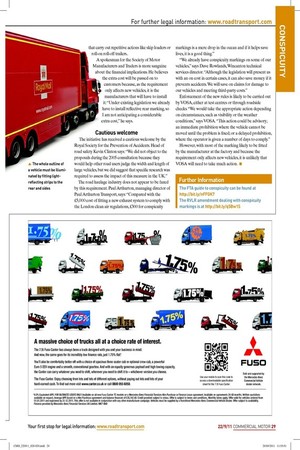Seen in all the right places
Page 17

Page 18

If you've noticed an error in this article please click here to report it so we can fix it.
All new vehicles and trailers must now be fitted with reflective tape. Will fewer accidents justify the extra cost?
Words: Mike Sherrington The old road safety adage ‘wear something bright at night’ now applies to HGVs. From 10 July this year all new vehicles over 7.5 tonnes have to comply with European Union regulations that mean the whole outline of a vehicle must be illuminated by itting light-relecting strips to the rear and sides.
The Department for Transport estimates that if every vehicle in this category carried these marking then 76 serious or fatal accidents a year could be prevented. However, this will take a long time to achieve because there are no plans to impose the directive retrospectively. The whole of the nation’s leet will carry these markings only when all vehicles have been replaced by new ones.
The introduction of the new ruling has been delayed. It was mooted for inclusion with revised Road Vehicle and Lighting Regulations, published in October 2009. However, faced with initial opposition from both the Freight Transport Association and the Road Haulage Association and the need to iron out some technical problems, the DfT decided to delay introduction until this July. “When we were originally consulted, we were opposed to the idea because we wondered if the use of very expensive relective tape was the best solution. However, there is no doubt about the safety case,” says Andy Mair, the FTA head of engineering policy.
Definitive guide
Now the requirement has been adopted, Mair has penned the deinitive guide Conspicuity marking requirements on goods vehicles, which has been published by the FTA in conjunction with the DfT. “With so many different body types in use, we thought it was necessary to publish an easy-to-follow set of guidelines to make implementation more straightforward,” says Mair.
He estimates that it will cost up to £300 per vehicle to it the tape and that certain types of vehicles may have to replace this more than once in its lifetime.
Cost was also a factor in the RHA originally opposing the proposals. Its specialist groups manager Nick Deal is worried about the cost of reapplying the tape to vehicles that carry out repetitive actions like skip loaders or roll-on roll-off trailers..
A spokesman for the Society of Motor Manufacturers and Traders is more sanguine about the inancial implications. He believes the extra cost will be passed on to customers because, as the requirement only affects new vehicles, it is the manufacturers that will have to install it: “Under existing legislation we already have to install relective rear marking, so I am not anticipating a considerable extra cost,” he says.
Cautious welcome
The initiative has received a cautious welcome by the Royal Society for the Prevention of Accidents. Head of road safety Kevin Clinton says: “We did not object to the proposals during the 2005 consultation because they would help other road users judge the width and length of large vehicles, but we did suggest that speciic research was required to assess the impact of this measure in the UK.” The road haulage industry does not appear to be fazed by this requirement. Paul Arthurton, managing director of Paul Arthurton Transport, says: “Compared with the £5,000 cost of itting a new exhaust system to comply with the London clean air regulations, £300 for conspicuity markings is a mere drop in the ocean and if it helps save lives, it is a good thing.” “We already have conspicuity markings on some of our vehicles,” says Dave Rowlands, Wincanton technical services director. “Although the legislation will present us with an on cost in certain cases, it can also save money if it prevents accidents. We will save on claims for damage to our vehicles and meeting third-party costs.” Enforcement of the new rules is likely to be carried out by VOSA, either at test centres or through roadside checks. “We would take the appropriate action depending on circumstances, such as visibility or the weather conditions,” says VOSA. “This action could be advisory; an immediate prohibition where the vehicle cannot be moved until the problem is ixed; or a delayed prohibition, where the operator is given a number of days to comply.”
However, with most of the marking likely to be itted by the manufacturer at the factory and because the requirement only affects new vehicles, it is unlikely that VOSA will need to take much action. n




































